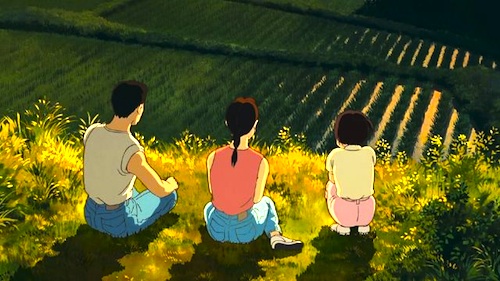By Joe Bendel. At twenty-seven, Taeko Okajima ought to be too young for a midlife crisis, but she carries a lot of baggage from her difficult childhood. However, she might finally start to work through her issues when she lugs her “fifth grade self” along on her vacation to the countryside. Although it was a Japanese box office hit in 1991, Isao Takahata’s animated memory play remained the one Studio Ghibli film that was never theatrically distributed in North America. Fortunately, GKIDS has rectified this frustrating situation with a proper release of Takahata’s straight-up masterpiece Only Yesterday which continues it special two-week, twenty-fifth anniversary release in New York, at the IFC Center.
Okajima’s desire to vacation in the country can be immediately attributed to the frustrations of her childhood. As she boards the train taking her out of Tokyo, she remembers with bitterness being the only member of her fifth grade class who did not have a country getaway lined-up for summer break. Her parents seemed to have two specialties, berating her for her low marks in mathematics and dashing her dreams. However, young Okajima is not the perfect picture of innocence either. In fact, the memories that will be most difficult to work through involve her guilt for mistreating less popular classmates.
In contrast, her time spent with her bother-in-law’s rugged country relations is quite pleasant for Okajima. She genuinely enjoys harvesting the safflowers, a blooming thistle whose pigments are used for cosmetics and dyes. She and Toshio (the second cousin of her sister’s husband) hit it off particularly well. There could even be something more than friendship between them, but it is not clear Okajima’s head is ready for it.
You do not see very many films, live action or animated, that are as emotionally complex as Only Yesterday. While the 1966 flashbacks were based on a successful manga, Takahata developed the original 1980s wrap-arounds, which really take on a life of their own. In fact, seeing the psychological ripple effects years later make the childhood sequences far richer. Consequently, when Takahata delivers the massive payoff, it happens in the eighties.
Of course, Only Yesterday looks absolutely gorgeous. Studio Ghibli’s affinity for safflower fields hardly needs explaining for their fans. The figures are also rendered with unusual sensitivity, particularly 1980s Taeko and Toshio. If you do not quickly take a shine to them, you must be one grumpy old goat. Yet, what really stands out in the film is Takahata’s confident patience to let dialogue fully play out. Early in the film, Toshio and Okajima have a long conversation while he drives her to the farm from the station. It deceptively sounds like small talk, but it really establishes both their characters, as well as the film’s major themes. Frankly, they are just worth listening to.

For the English dub, GKIDS scored a bit of a coup with the casting of Daisy Ridley, currently seen in something called The Force Awakes, as the voice of twenty-seven year old Okajima. However, Japanese pop singer Miki Imai is so perfect in the role, it is still worth opting for the subtitled original version (which the IFC Center is also running for the film’s screenings after 8:00 pm).
Some animation fans consider Only Yesterday a watershed for its mature and realistic portrayal of a woman in adulthood. That may well be so, but it is such a human and humane film, just about everyone ought to be able to relate to it. A wonderful example of studio Ghibli’s artistry, Only Yesterday continues its special, worth-the-wait engagement at the IFC Center, with a national release later scheduled for February 26th.
LFM GRADE: A+
Posted on January 8th, 2016 at 7:07pm.